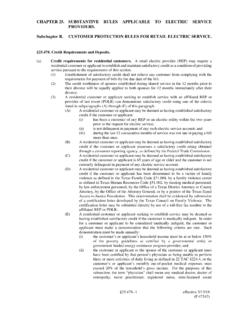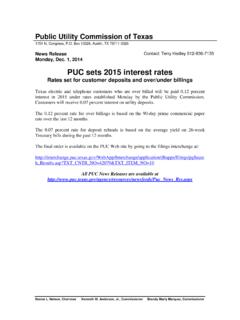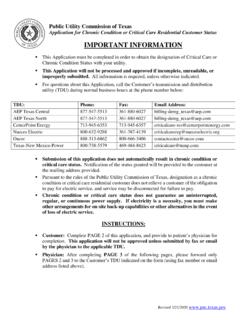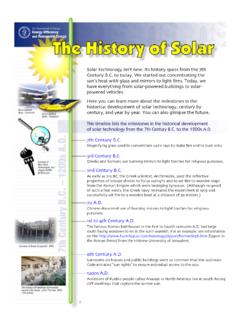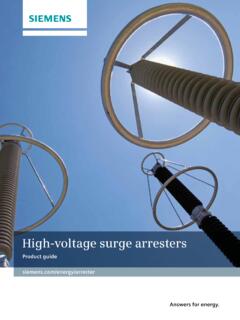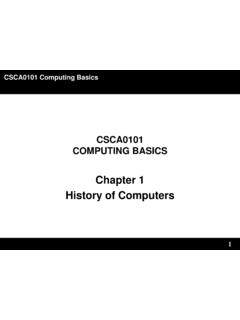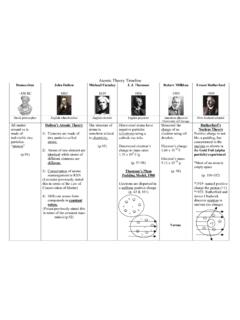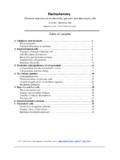Transcription of The Timeline and Events of the February 2021 Texas ...
1 The Timeline and Events of the February 2021 Texas Electric Grid Blackouts July 2021. [Type here]. The Timeline and Events of the February 2021 Texas Electric Grid Blackouts A report by a committee of faculty and staff at The University of Texas at Austin July 2021. COMMITTEE CHAIRS. Carey W. King, Research Scientist, Assistant Director, Energy Institute Josh D. Rhodes, Research Associate, Department of Mechanical Engineering Jay Zarnikau, Research Fellow, Department of Economics COMMITTEE MEMBERS. Contributing Authors Ning Lin, Chief Economist, Bureau of Economic Geology Additional Members Erhan Kutanoglu, Associate Professor, Operations Research and Industrial Engineering, Department of Mechanical Engineering Benjamin Leibowicz, Assistant Professor, Operations Research and Industrial Engineering, Department of Mechanical Engineering Dev Niyogi, Professor, Department of Geological Sciences; Professor, Department of Civil, Architectural, and Environmental Engineering Varun Rai, Professor, LBJ School of Public Affairs; Director, Energy Institute Surya Santoso, Professor, Department of Electrical and Computer Engineering David Spence, Baker Botts Chair in Law, School of Law; Professor, Department of Business, Government, and Society Stathis Tompaidis, Professor, Department of Information, Risk and Operations Management, and by courtesy, Department of Finance Hao Zhu, Assistant Professor, Department of Electrical and Computer Engineering OTHER CONTRIBUTORS.
2 Erik Funkhouser, Director for Research Coordination and Partnerships, Energy Institute Brent Austgen, Graduate Research Assistant, Operations Research and Industrial Engineering Program, Department of Mechanical Engineering 1. Table of Contents Executive Summary .. 7. 1. Introduction .. 12. Objective .. 12. Energy in Texas .. 13. 2. Timeline of Events Related to February 2021 ERCOT Blackouts. 15. ERCOT's Winter 2020/2021 SARA report .. 15. The Week Before Winter Storm Uri .. 18. Weather and Load Forecasts and 18. Recall of Power Plant Outages for Maintenance .. 24. The Week of Winter Storm Uri ( February 13-20, 2021) .. 25. Generation Outages ( Timeline ) .. 28. Generator Temperature Ratings Relative to Experienced Temperatures . 34. Load Curtailment, Requested and Achieved .. 36. Involuntary Load Shed .. 36. Response to High Prices .. 37. Deployment of Load Resources .. 38. ERS Program .. 38. Automated Load Shedding via Under-frequency Relays .. 39. Deployment of Various Demand Response (DR) Programs by Load- Serving Entities.
3 40. Aggregate Levels of Demand Response .. 41. Natural Gas and Operations during February 41. Natural Gas Production .. 41. Storage .. 45. Natural Gas Demand .. 48. Exports By Pipeline and Liquified Natural Gas (LNG) .. 52. Texas Pipeline Exports .. 53. Texas LNG 55. Natural Gas Infrastructure Participation in Load 56. 3. electricity and Natural Gas Financial Flows and Prices .. 57. Energy Prices .. 57. Ancillary Service 59. PUCT Orders During February Blackout .. 59. electricity Market Price Changes/Corrections During the Event .. 60. Financial Fallout .. 64. 2. 4. A Comparison to Winter Events in 2011 and 1989 .. 70. December 1989 Winter Event .. 70. February 2011 Winter Event .. 71. Comparison of the Three Events .. 73. 5. Summary .. 76. Acknowledgements .. 77. Conflict of Interest Statements .. 78. References .. 79. Appendix A. Short History of Texas Electric Grid and ERCOT: From the Beginning to 2021 .. 82. Why Does Texas Have Its Own Grid?.. 82. Wholesale Market Restructuring (Deregulation) and Adjustment Timeline .
4 84. Why isn't ERCOT Connected to Other Grids? .. 87. Today's ERCOT Wholesale Market .. 88. Characteristics of the ERCOT Retail market .. 88. Summary: ERCOT History and Current Status .. 90. Appendix B. Internal ERCOT Meteorological Discussions Before the Storm .. 92. Appendix C. Generator Outages Relative to Time Reaching Freezing Temperature .. 94. Appendix D. Texas Natural Gas Balance .. 97. Appendix E. Other (non-energy) Infrastructures Impacted from Storm: Water and Housing .. 100. 3. List of Figures Chapter One Figure .. 13. Chapter Two Figure 16. Figure ..17. Figure 18. Figure .. 19. Figure .. 22. Figure .. 22. Figure .. 24. Figure .. 24. Figure .. 25. Figure .. 27. Figure Figure ..29. Figure .. 30. Figure .. 33. Figure .. 34. Figure .. 35. Figure .. 42. Figure .. 43. Figure .. 43. Figure .. 44. Figure .. 46. Figure 46. Figure .. 47. Figure 47. Figure .. 48. Figure .. 49. Figure .. 49. Figure .. 51. Figure .. 51. Figure .. 52. Figure .. 53. Figure 54. Figure.
5 54. Figure .. 55. Figure .. 56. 4. Chapter Three Figure .. 58. Figure .. 59. Figure .. 61. Figure .. 63. Figure .. 64. Appendix A. Figure .. 89. Figure .. 91. Appendix C. Figure .. 95. Appendix D. Figure ..97. Figure .. 99. Figure .. 99. 5. List of Tables Chapter Two Table .. 27. Table .. 39. Chapter Three Table .. 63. Chapter Four Table .. 74. Appendix A. Table .. 85. 6. Executive Summary Objective This report recounts the factors contributing to disruptions in electricity and natural gas service in Texas during Winter Storm Uri, with a particular focus on blackouts on the Electric Reliability Council of Texas (ERCOT) grid during the period from February 15-18, 2021. Our goal is to create a common basis of fact to educate the debate over strategies to avoid similar problems in the future. We specifically limited the scope of this report to the Events during February 2021, a comparison of the February 2021. event to the previous energy system disruptions in 1989 and 2011 during winter storms, and the economic consequences of the event in February 2021.
6 An appendix describes the long-term evolution of the ERCOT electricity market and provides historical context. This report is not intended to comprehensively address all issues stemming from such a complex event, but may inform subsequent assessments. This report does not recommend policies or solutions. Data To perform the analysis presented in this report, we reviewed a variety of public information sources, analyses conducted by the staff of ERCOT, testimony before state legislative committees, and public data archives provided by ERCOT. In addition, and through an agreement with the Public Utility Commission of Texas (PUCT), select members of our project team were provided access to certain confidential data collected by the PUCT and ERCOT pertaining to the performance of specific electric generating units, enrollment of energy consumers in ERCOT's Emergency Response Service program, communications regarding the winter storm, and other relevant We also used a proprietary source of data to explore the performance of the natural gas industry during the event.
7 We further considered and analyzed meteorological and other technical data that groups within the University of Texas at Austin (UT) have acquired for other research purposes. Findings The failure of the electricity and natural gas systems serving Texas before and during Winter Storm Uri in February 2021 had no single cause. While the 2021 storm did not set records for the lowest recorded temperatures in many parts of the state, it caused generation outages and a loss of electricity service to Texas customers several times more severe than winter Events leading to electric service disruptions in December 1989 and February 2011. The 2021 event exceeded prior Events with respect to both the number and capacity of generation unit outages, the maximum 1 Josh Rhodes and Carey King of the project team were provided access to the confidential data. 7. load shed (power demand reduction) and number of customers affected, the lowest experienced grid frequency (indicating a high level of grid instability), the amount of natural gas generation experiencing fuel shortages, and the duration of electric grid operations under emergency conditions associated with load shed and blackout for customers.
8 The financial ramifications of the 2021 event are in the billions of dollars, likely orders of magnitude larger than the financial impacts of the 1989 and 2011. blackouts. Factors contributing to the electricity blackouts of February 15-18, 2021 include the following: All types of generation technologies failed. All types of power plants were impacted by the winter storm. Certain power plants within each category of technologies (natural gas-fired power plants, coal power plants, nuclear reactors, wind generation, and solar generation facilities) failed to operate at their expected electricity generation output levels. Demand forecasts for severe winter storms were too low. ERCOT's most extreme winter scenario underestimated demand relative to what actually happened by about 9,600 MW, about 14%. Weather forecasts failed to appreciate the severity of the storm. Weather models were unable to accurately forecast the timing (within one to two days) and severity of extreme cold weather, including that from a polar vortex.
9 Planned generator outages were high, but not much higher than assumed in planning scenarios. Total planned outage capacity was about 4,930 MW, or about 900 MW higher than in ERCOT's Forecasted Season Peak Load . scenario. Grid conditions deteriorated rapidly early in February 15 leading to blackouts. So much power plant capacity was lost relative to the record electricity demand that ERCOT was forced to shed load to avoid a catastrophic failure. From noon on February 14 to noon on February 15, the amount of offline wind capacity increased from 14,600 MW to 18,300 MW (+3,700 MW).2. Offline natural gas capacity increased from 12,000 MW to 25,000 MW. (+13,000 MW). Offline coal capacity increased from 1,500 MW to 4,500 MW. (+3,000 MW). Offline nuclear capacity increased from 0 MW to 1,300 MW, and offline solar capacity increased from 500 MW to 1100 MW (+600 MW), for a total loss of 24,600 MW in a single 24-hour period. 2 For wind and solar electricity generation, nameplate capacity is not a meaningful measure of the amount of power generation expected when the unit is not experencing an outage, though nameplate capacity provides a meaningful metric for the thermal fleet of power plants ( , coal, nuclear, and natural gas-fired generating units).
10 Using backcasted values of the available wind and solar radiation, available wind capacity outages actually decreased from 9,070 MW to 5,020 MW (-4,050) over the same time period and solar outages increased less, from 108 MW to 545 MW (+437 MW). 8. Power plants listed a wide variety of reasons for going offline throughout the event. 3 Reasons for power plant failures include weather-related issues (30,000 MW, ~167 units), equipment issues (5,600 MW, 146 units), fuel limitations (6,700 MW, 131 units), transmission and substation outages . (1,900 MW, 18 units), and frequency issues (1,800 MW, 8 units). 4. Some power generators were inadequately weatherized; they reported a level of winter preparedness that turned out to be inadequate to the actual conditions experienced. The outage, or derating, of several power plants occurred at temperatures above their stated minimum temperature ratings. Failures within the natural gas system exacerbated electricity problems. Natural gas production, storage, and distribution facilities failed to provide the full amount of fuel demanded by natural gas power plants.


